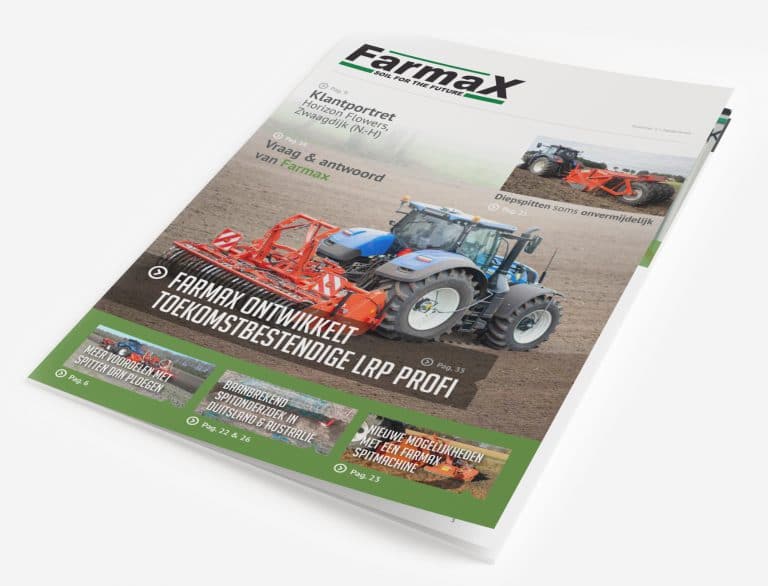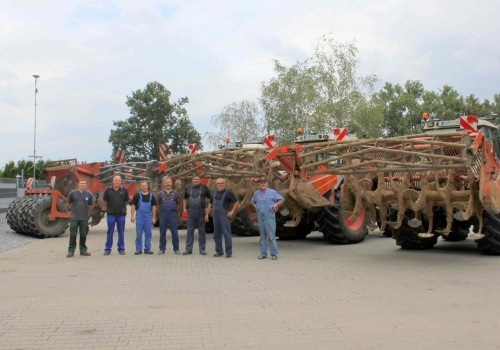
Experiences with drought damage in Australia offers new perspectives for arable farmers
Strip spading limits drought damage and wind erosion.
The weather in Australia can take extreme forms. In addition to long heat waves, massive forest fires, as we know them from 2019. The results from extreme drought and wind erosion is a eyesore for Australian arable farmers. For this reason, Australian farmers and researchers are developing new methods to limit the negative effects of drought. One of these methods is spading. Alfons Sleiderink, director of Farmax, explains: “The weather forecast for western Europe is an extremely dry growing season. So let arable farmers take a look at the experiences they have gained in Australia. It is interesting to see how they deal with dry periods to secure their yield”.
Research in South Australia
The University of South Australia contacted Farmax in 2015. The aim was to investigate the effect of spading on sandy soils in a dry climate. There are Australian farmers who apply a layer of clay to their fields. This is mixed in the top soil to increase water retention. One of the innovations that is being tested in Australia is strip spading. Due to the drought in Australia, sandy soils that had full soil cultivation have a greater chance of wind erosion. They want to investigate wether this treatment improves the soil structure and limits the consequences of wind erosion. Strip spading is only cultivating the soil where the seed/plants should be. Between the strips, the soil remains untreated with crop (residues) from the previous year. Strip spading allows the soil to be cultivated deeper than milling strips.
In 2019, strip spading in Wynarka (South Australia) was compared with other types of soil cultivation. In this study, the following things were concluded: a yield increase of 15% on the test plot could be achieved by combining strip spading and sowing barley in one pass. The seed had direct access to the soil moisture. In the study, a comparison was made with a ripping operation where sowing took place 2 days later. The top soil (5 centimeters) appeared to have dried out within 48 hours. The main explanation for the increase in yield was a higher germination and less wind erosion due to strip spading.

Strip spading in the Netherlands
As a result of the study in Australia, strip spading it is being examined whether it also offers new insights for European agriculture. Farmax’s experiences in Australia have been used in the Netherlands to build a strip spading prototype. With this strip spader, Farmax wants to study the effects of strip cultivation on the growth, yield, capillary effect and soil conditions. In the spring of 2020, a test plot was spaded into strips with corn sown in one pass. This season we keep track of how the effects of this operation will develop.
Agricultural research to limit drought damage
Recent practical experiences in Australia
- Arable farming in South Australia mainly takes place on sandy soils. Some arable farmers have been applying clay and organic matter to their soil for several years. With a spading machine they mix this through the top soil, so that the water retention and soil fertility improves.
- The University of South Australia is investigating new soil improvement techniques to counteract the effects of drought. One of these methods is spading, which also includes strip spading.
After positive experiences of Australian arable farmers with spading they contacted Farmax. Since 2015, they have been carrying out field tests with a spading machine. Farmax has made a LRP Profi Trailed available for this. - The research focuses on the mixing effect of the spading machine. Spading speeds and the design of the spades are central in this research. A link has also been established between the mixing of organic matter and the effect on the soil conditions. The University is also conducting researches on strip cultivation.
- At a test location in South Australia, the effect of different spading speeds on the mixing effect in the soil has been compared. The results are taken from the test data using a simulation program. The conclusion is that spading speed does make a distinction between the mixing effect of crop residues in the soil:
– Up to the first ten centimeters, a higher spading speed mixes better than a lower one.
– From ten centimeters, a spading machine mixes better at a lower spading speed.
– This study uses organic dyes that are mixed during the spading. - An important aspect is the effect of spading on the water retention and soil fertility. Non-tillage is widely used cultivation in Australia. During the research, chicken manure was applied to a sandy soil and was mixed in with a spading machine. The soil was better able to retain the rainwater and deliver it to the plant in the first 400 mm due to the introduction of more organic matter. Mixed manure in the siol resulted in a yield increase of 600 kg on the test plot. In addition, there is of course a structural improvement in soil fertility on the longer term. Full spading must be weighed up against the risk of wind erosion.
- From a technical perspective, the design of the Farmax spaded has been studied. In addition to the current design, other spades have also been tested. The current spaded consists of 3 spades per flange. New designs with 4 shovels, wider shovels or wider distance between the flanges on the spading rotor have been tested. The amount of torque the machine needs was tested on a light sandy soil. The study showed that the current design requires between 10 and 30% less torque than other tested designs. This means that the current design has less soil resistance. The effects on fuel consumption have not yet been further analyzed.

Download the free magazine of Farmax spaders and seeders
In this magazine, we will explain the spading method of soil preparation and state its advantages in comparison with ploughing. There will also be a brief explanation of all types of spaders and several customers share their experience with our spaders.










